Evaluation of Consulting Methods for the Retail Apocalypse Problem
VerifiedAdded on 2022/09/18
|9
|2262
|35
Report
AI Summary
This report provides a comprehensive analysis of the retail apocalypse, a complex organizational problem characterized by the decline of UK high street retailers. The author evaluates three prominent consulting methods—Soft Systems Methodology (SSM), Structured Problem Diagnosis (SPD), and SCQA—to assess their effectiveness in addressing this issue. The report begins with an introduction that highlights the factors contributing to the retail decline, such as technological advancements, e-commerce, and high property costs. The core of the report involves a detailed examination of each consulting method, outlining their strengths and weaknesses in the context of the retail apocalypse. SSM is lauded for its ability to provide a visual representation of the problem through rich pictures, while SPD is praised for its structured approach to problem diagnosis and solution development. SCQA is valued for its thorough analysis of the situation. The author then presents a comparative analysis, discussing the limitations of each method and suggesting potential solutions, such as lease model changes and portfolio expansion. The report concludes by recommending SSM as the most robust method for understanding the complex dynamics of the retail apocalypse due to its ability to provide a detailed visual representation of the problem.
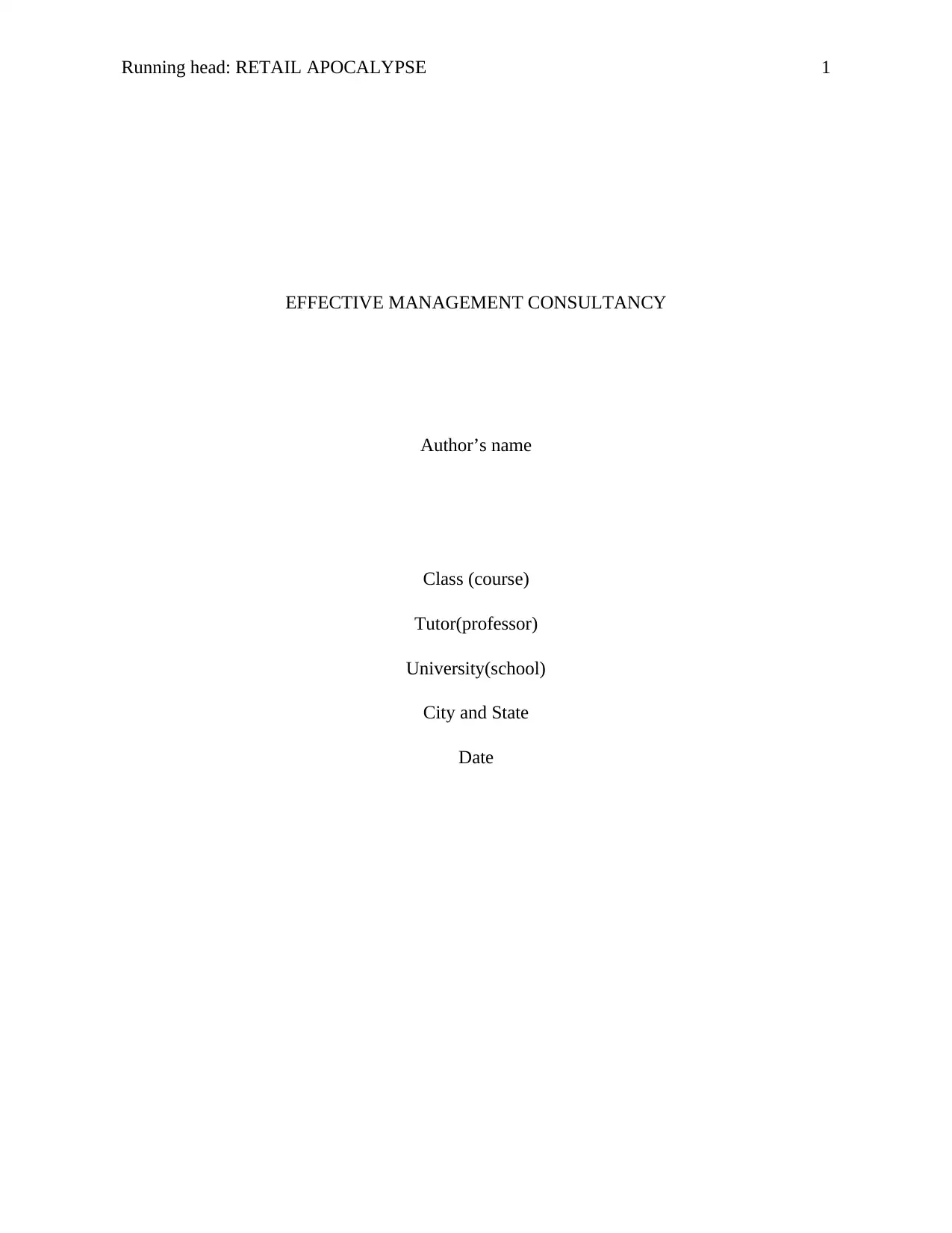
Running head: RETAIL APOCALYPSE 1
EFFECTIVE MANAGEMENT CONSULTANCY
Author’s name
Class (course)
Tutor(professor)
University(school)
City and State
Date
EFFECTIVE MANAGEMENT CONSULTANCY
Author’s name
Class (course)
Tutor(professor)
University(school)
City and State
Date
Paraphrase This Document
Need a fresh take? Get an instant paraphrase of this document with our AI Paraphraser
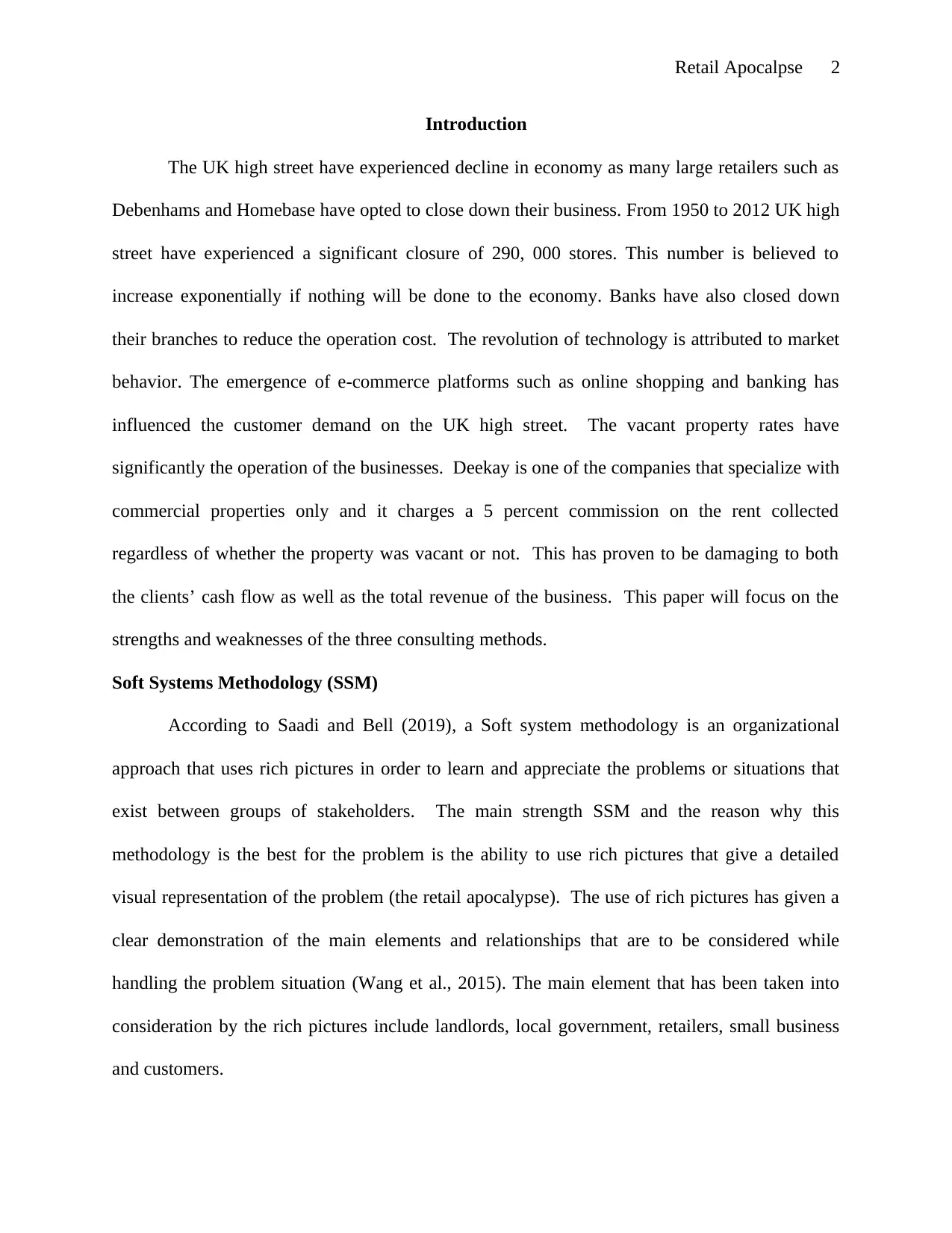
Retail Apocalpse 2
Introduction
The UK high street have experienced decline in economy as many large retailers such as
Debenhams and Homebase have opted to close down their business. From 1950 to 2012 UK high
street have experienced a significant closure of 290, 000 stores. This number is believed to
increase exponentially if nothing will be done to the economy. Banks have also closed down
their branches to reduce the operation cost. The revolution of technology is attributed to market
behavior. The emergence of e-commerce platforms such as online shopping and banking has
influenced the customer demand on the UK high street. The vacant property rates have
significantly the operation of the businesses. Deekay is one of the companies that specialize with
commercial properties only and it charges a 5 percent commission on the rent collected
regardless of whether the property was vacant or not. This has proven to be damaging to both
the clients’ cash flow as well as the total revenue of the business. This paper will focus on the
strengths and weaknesses of the three consulting methods.
Soft Systems Methodology (SSM)
According to Saadi and Bell (2019), a Soft system methodology is an organizational
approach that uses rich pictures in order to learn and appreciate the problems or situations that
exist between groups of stakeholders. The main strength SSM and the reason why this
methodology is the best for the problem is the ability to use rich pictures that give a detailed
visual representation of the problem (the retail apocalypse). The use of rich pictures has given a
clear demonstration of the main elements and relationships that are to be considered while
handling the problem situation (Wang et al., 2015). The main element that has been taken into
consideration by the rich pictures include landlords, local government, retailers, small business
and customers.
Introduction
The UK high street have experienced decline in economy as many large retailers such as
Debenhams and Homebase have opted to close down their business. From 1950 to 2012 UK high
street have experienced a significant closure of 290, 000 stores. This number is believed to
increase exponentially if nothing will be done to the economy. Banks have also closed down
their branches to reduce the operation cost. The revolution of technology is attributed to market
behavior. The emergence of e-commerce platforms such as online shopping and banking has
influenced the customer demand on the UK high street. The vacant property rates have
significantly the operation of the businesses. Deekay is one of the companies that specialize with
commercial properties only and it charges a 5 percent commission on the rent collected
regardless of whether the property was vacant or not. This has proven to be damaging to both
the clients’ cash flow as well as the total revenue of the business. This paper will focus on the
strengths and weaknesses of the three consulting methods.
Soft Systems Methodology (SSM)
According to Saadi and Bell (2019), a Soft system methodology is an organizational
approach that uses rich pictures in order to learn and appreciate the problems or situations that
exist between groups of stakeholders. The main strength SSM and the reason why this
methodology is the best for the problem is the ability to use rich pictures that give a detailed
visual representation of the problem (the retail apocalypse). The use of rich pictures has given a
clear demonstration of the main elements and relationships that are to be considered while
handling the problem situation (Wang et al., 2015). The main element that has been taken into
consideration by the rich pictures include landlords, local government, retailers, small business
and customers.
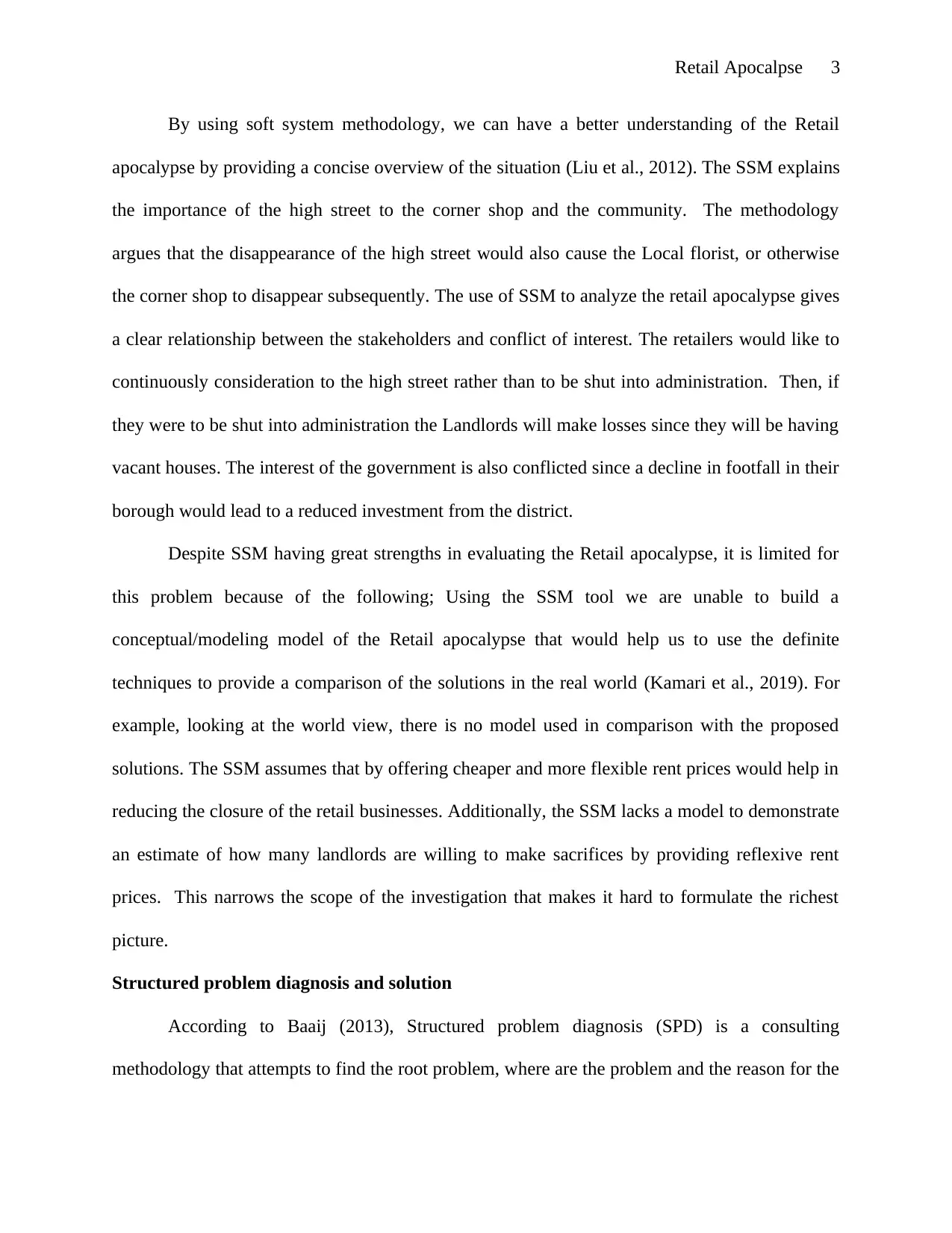
Retail Apocalpse 3
By using soft system methodology, we can have a better understanding of the Retail
apocalypse by providing a concise overview of the situation (Liu et al., 2012). The SSM explains
the importance of the high street to the corner shop and the community. The methodology
argues that the disappearance of the high street would also cause the Local florist, or otherwise
the corner shop to disappear subsequently. The use of SSM to analyze the retail apocalypse gives
a clear relationship between the stakeholders and conflict of interest. The retailers would like to
continuously consideration to the high street rather than to be shut into administration. Then, if
they were to be shut into administration the Landlords will make losses since they will be having
vacant houses. The interest of the government is also conflicted since a decline in footfall in their
borough would lead to a reduced investment from the district.
Despite SSM having great strengths in evaluating the Retail apocalypse, it is limited for
this problem because of the following; Using the SSM tool we are unable to build a
conceptual/modeling model of the Retail apocalypse that would help us to use the definite
techniques to provide a comparison of the solutions in the real world (Kamari et al., 2019). For
example, looking at the world view, there is no model used in comparison with the proposed
solutions. The SSM assumes that by offering cheaper and more flexible rent prices would help in
reducing the closure of the retail businesses. Additionally, the SSM lacks a model to demonstrate
an estimate of how many landlords are willing to make sacrifices by providing reflexive rent
prices. This narrows the scope of the investigation that makes it hard to formulate the richest
picture.
Structured problem diagnosis and solution
According to Baaij (2013), Structured problem diagnosis (SPD) is a consulting
methodology that attempts to find the root problem, where are the problem and the reason for the
By using soft system methodology, we can have a better understanding of the Retail
apocalypse by providing a concise overview of the situation (Liu et al., 2012). The SSM explains
the importance of the high street to the corner shop and the community. The methodology
argues that the disappearance of the high street would also cause the Local florist, or otherwise
the corner shop to disappear subsequently. The use of SSM to analyze the retail apocalypse gives
a clear relationship between the stakeholders and conflict of interest. The retailers would like to
continuously consideration to the high street rather than to be shut into administration. Then, if
they were to be shut into administration the Landlords will make losses since they will be having
vacant houses. The interest of the government is also conflicted since a decline in footfall in their
borough would lead to a reduced investment from the district.
Despite SSM having great strengths in evaluating the Retail apocalypse, it is limited for
this problem because of the following; Using the SSM tool we are unable to build a
conceptual/modeling model of the Retail apocalypse that would help us to use the definite
techniques to provide a comparison of the solutions in the real world (Kamari et al., 2019). For
example, looking at the world view, there is no model used in comparison with the proposed
solutions. The SSM assumes that by offering cheaper and more flexible rent prices would help in
reducing the closure of the retail businesses. Additionally, the SSM lacks a model to demonstrate
an estimate of how many landlords are willing to make sacrifices by providing reflexive rent
prices. This narrows the scope of the investigation that makes it hard to formulate the richest
picture.
Structured problem diagnosis and solution
According to Baaij (2013), Structured problem diagnosis (SPD) is a consulting
methodology that attempts to find the root problem, where are the problem and the reason for the
⊘ This is a preview!⊘
Do you want full access?
Subscribe today to unlock all pages.

Trusted by 1+ million students worldwide
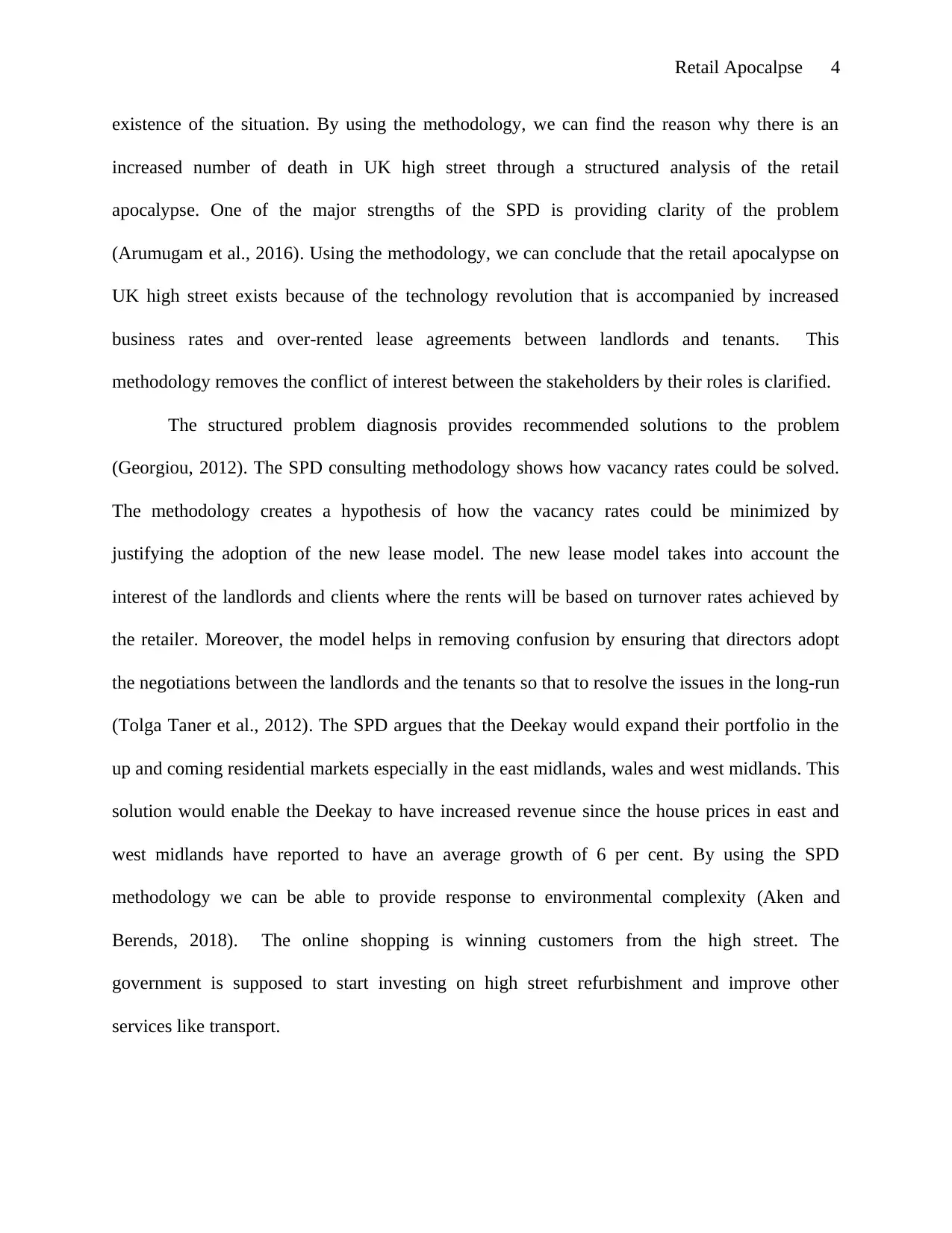
Retail Apocalpse 4
existence of the situation. By using the methodology, we can find the reason why there is an
increased number of death in UK high street through a structured analysis of the retail
apocalypse. One of the major strengths of the SPD is providing clarity of the problem
(Arumugam et al., 2016). Using the methodology, we can conclude that the retail apocalypse on
UK high street exists because of the technology revolution that is accompanied by increased
business rates and over-rented lease agreements between landlords and tenants. This
methodology removes the conflict of interest between the stakeholders by their roles is clarified.
The structured problem diagnosis provides recommended solutions to the problem
(Georgiou, 2012). The SPD consulting methodology shows how vacancy rates could be solved.
The methodology creates a hypothesis of how the vacancy rates could be minimized by
justifying the adoption of the new lease model. The new lease model takes into account the
interest of the landlords and clients where the rents will be based on turnover rates achieved by
the retailer. Moreover, the model helps in removing confusion by ensuring that directors adopt
the negotiations between the landlords and the tenants so that to resolve the issues in the long-run
(Tolga Taner et al., 2012). The SPD argues that the Deekay would expand their portfolio in the
up and coming residential markets especially in the east midlands, wales and west midlands. This
solution would enable the Deekay to have increased revenue since the house prices in east and
west midlands have reported to have an average growth of 6 per cent. By using the SPD
methodology we can be able to provide response to environmental complexity (Aken and
Berends, 2018). The online shopping is winning customers from the high street. The
government is supposed to start investing on high street refurbishment and improve other
services like transport.
existence of the situation. By using the methodology, we can find the reason why there is an
increased number of death in UK high street through a structured analysis of the retail
apocalypse. One of the major strengths of the SPD is providing clarity of the problem
(Arumugam et al., 2016). Using the methodology, we can conclude that the retail apocalypse on
UK high street exists because of the technology revolution that is accompanied by increased
business rates and over-rented lease agreements between landlords and tenants. This
methodology removes the conflict of interest between the stakeholders by their roles is clarified.
The structured problem diagnosis provides recommended solutions to the problem
(Georgiou, 2012). The SPD consulting methodology shows how vacancy rates could be solved.
The methodology creates a hypothesis of how the vacancy rates could be minimized by
justifying the adoption of the new lease model. The new lease model takes into account the
interest of the landlords and clients where the rents will be based on turnover rates achieved by
the retailer. Moreover, the model helps in removing confusion by ensuring that directors adopt
the negotiations between the landlords and the tenants so that to resolve the issues in the long-run
(Tolga Taner et al., 2012). The SPD argues that the Deekay would expand their portfolio in the
up and coming residential markets especially in the east midlands, wales and west midlands. This
solution would enable the Deekay to have increased revenue since the house prices in east and
west midlands have reported to have an average growth of 6 per cent. By using the SPD
methodology we can be able to provide response to environmental complexity (Aken and
Berends, 2018). The online shopping is winning customers from the high street. The
government is supposed to start investing on high street refurbishment and improve other
services like transport.
Paraphrase This Document
Need a fresh take? Get an instant paraphrase of this document with our AI Paraphraser
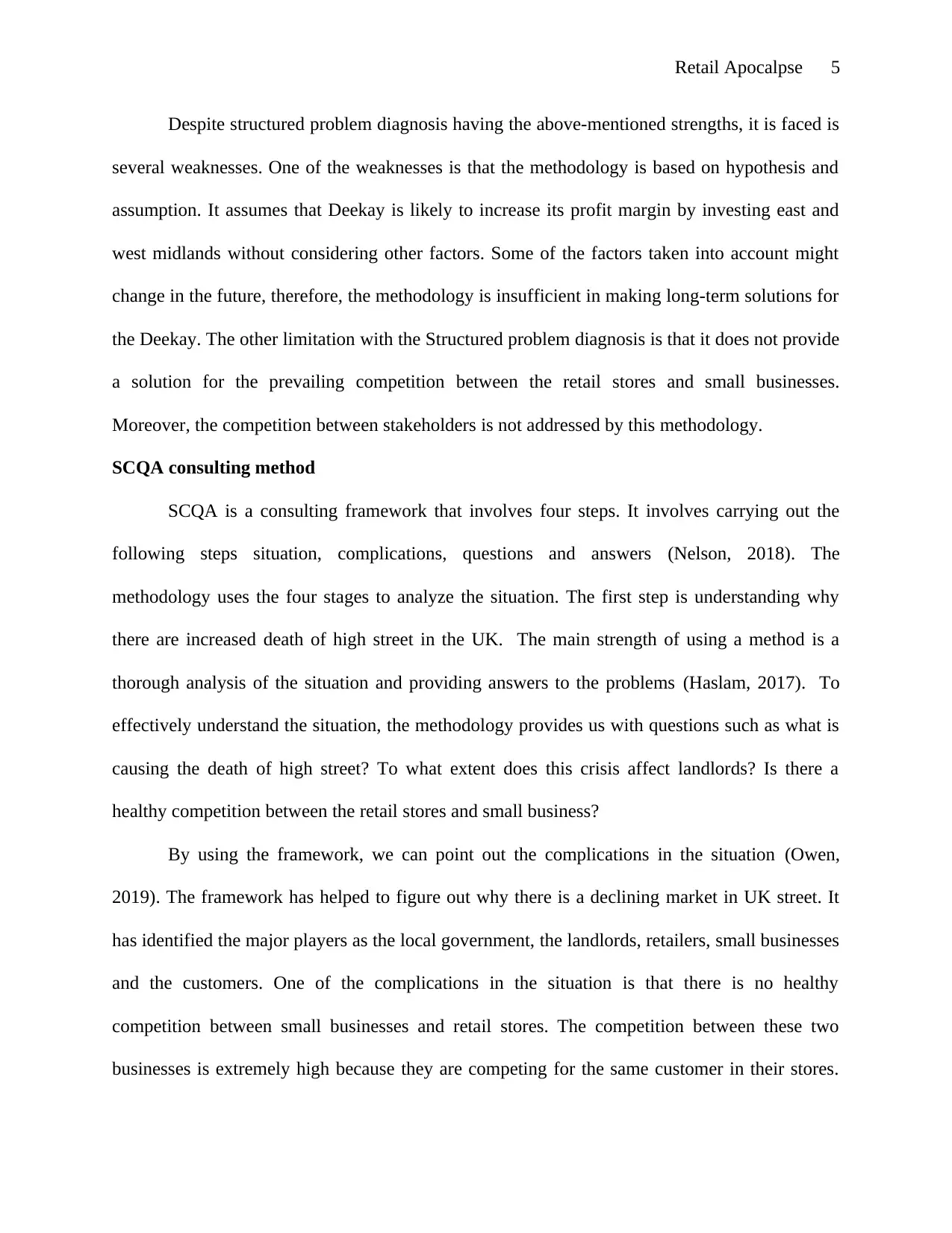
Retail Apocalpse 5
Despite structured problem diagnosis having the above-mentioned strengths, it is faced is
several weaknesses. One of the weaknesses is that the methodology is based on hypothesis and
assumption. It assumes that Deekay is likely to increase its profit margin by investing east and
west midlands without considering other factors. Some of the factors taken into account might
change in the future, therefore, the methodology is insufficient in making long-term solutions for
the Deekay. The other limitation with the Structured problem diagnosis is that it does not provide
a solution for the prevailing competition between the retail stores and small businesses.
Moreover, the competition between stakeholders is not addressed by this methodology.
SCQA consulting method
SCQA is a consulting framework that involves four steps. It involves carrying out the
following steps situation, complications, questions and answers (Nelson, 2018). The
methodology uses the four stages to analyze the situation. The first step is understanding why
there are increased death of high street in the UK. The main strength of using a method is a
thorough analysis of the situation and providing answers to the problems (Haslam, 2017). To
effectively understand the situation, the methodology provides us with questions such as what is
causing the death of high street? To what extent does this crisis affect landlords? Is there a
healthy competition between the retail stores and small business?
By using the framework, we can point out the complications in the situation (Owen,
2019). The framework has helped to figure out why there is a declining market in UK street. It
has identified the major players as the local government, the landlords, retailers, small businesses
and the customers. One of the complications in the situation is that there is no healthy
competition between small businesses and retail stores. The competition between these two
businesses is extremely high because they are competing for the same customer in their stores.
Despite structured problem diagnosis having the above-mentioned strengths, it is faced is
several weaknesses. One of the weaknesses is that the methodology is based on hypothesis and
assumption. It assumes that Deekay is likely to increase its profit margin by investing east and
west midlands without considering other factors. Some of the factors taken into account might
change in the future, therefore, the methodology is insufficient in making long-term solutions for
the Deekay. The other limitation with the Structured problem diagnosis is that it does not provide
a solution for the prevailing competition between the retail stores and small businesses.
Moreover, the competition between stakeholders is not addressed by this methodology.
SCQA consulting method
SCQA is a consulting framework that involves four steps. It involves carrying out the
following steps situation, complications, questions and answers (Nelson, 2018). The
methodology uses the four stages to analyze the situation. The first step is understanding why
there are increased death of high street in the UK. The main strength of using a method is a
thorough analysis of the situation and providing answers to the problems (Haslam, 2017). To
effectively understand the situation, the methodology provides us with questions such as what is
causing the death of high street? To what extent does this crisis affect landlords? Is there a
healthy competition between the retail stores and small business?
By using the framework, we can point out the complications in the situation (Owen,
2019). The framework has helped to figure out why there is a declining market in UK street. It
has identified the major players as the local government, the landlords, retailers, small businesses
and the customers. One of the complications in the situation is that there is no healthy
competition between small businesses and retail stores. The competition between these two
businesses is extremely high because they are competing for the same customer in their stores.
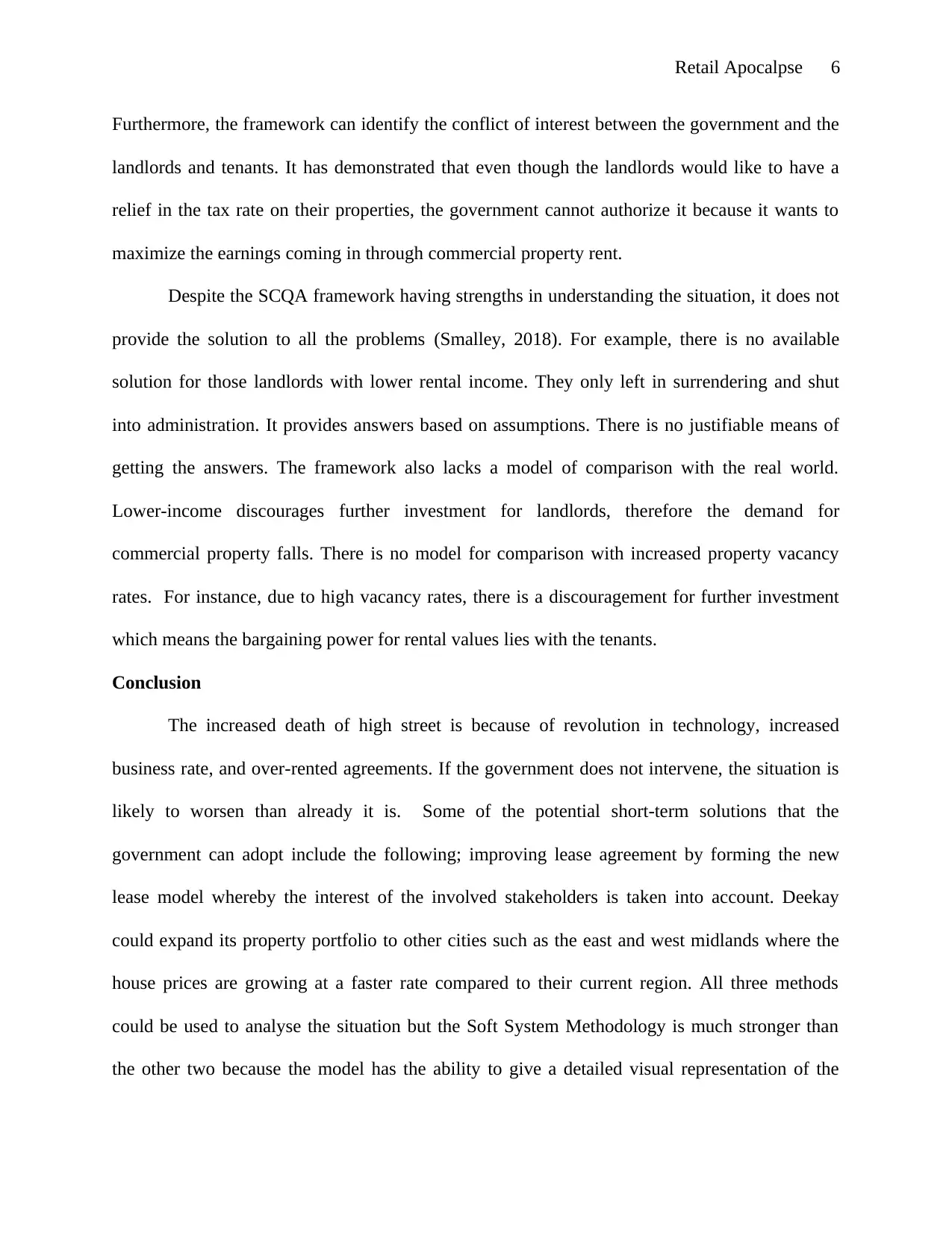
Retail Apocalpse 6
Furthermore, the framework can identify the conflict of interest between the government and the
landlords and tenants. It has demonstrated that even though the landlords would like to have a
relief in the tax rate on their properties, the government cannot authorize it because it wants to
maximize the earnings coming in through commercial property rent.
Despite the SCQA framework having strengths in understanding the situation, it does not
provide the solution to all the problems (Smalley, 2018). For example, there is no available
solution for those landlords with lower rental income. They only left in surrendering and shut
into administration. It provides answers based on assumptions. There is no justifiable means of
getting the answers. The framework also lacks a model of comparison with the real world.
Lower-income discourages further investment for landlords, therefore the demand for
commercial property falls. There is no model for comparison with increased property vacancy
rates. For instance, due to high vacancy rates, there is a discouragement for further investment
which means the bargaining power for rental values lies with the tenants.
Conclusion
The increased death of high street is because of revolution in technology, increased
business rate, and over-rented agreements. If the government does not intervene, the situation is
likely to worsen than already it is. Some of the potential short-term solutions that the
government can adopt include the following; improving lease agreement by forming the new
lease model whereby the interest of the involved stakeholders is taken into account. Deekay
could expand its property portfolio to other cities such as the east and west midlands where the
house prices are growing at a faster rate compared to their current region. All three methods
could be used to analyse the situation but the Soft System Methodology is much stronger than
the other two because the model has the ability to give a detailed visual representation of the
Furthermore, the framework can identify the conflict of interest between the government and the
landlords and tenants. It has demonstrated that even though the landlords would like to have a
relief in the tax rate on their properties, the government cannot authorize it because it wants to
maximize the earnings coming in through commercial property rent.
Despite the SCQA framework having strengths in understanding the situation, it does not
provide the solution to all the problems (Smalley, 2018). For example, there is no available
solution for those landlords with lower rental income. They only left in surrendering and shut
into administration. It provides answers based on assumptions. There is no justifiable means of
getting the answers. The framework also lacks a model of comparison with the real world.
Lower-income discourages further investment for landlords, therefore the demand for
commercial property falls. There is no model for comparison with increased property vacancy
rates. For instance, due to high vacancy rates, there is a discouragement for further investment
which means the bargaining power for rental values lies with the tenants.
Conclusion
The increased death of high street is because of revolution in technology, increased
business rate, and over-rented agreements. If the government does not intervene, the situation is
likely to worsen than already it is. Some of the potential short-term solutions that the
government can adopt include the following; improving lease agreement by forming the new
lease model whereby the interest of the involved stakeholders is taken into account. Deekay
could expand its property portfolio to other cities such as the east and west midlands where the
house prices are growing at a faster rate compared to their current region. All three methods
could be used to analyse the situation but the Soft System Methodology is much stronger than
the other two because the model has the ability to give a detailed visual representation of the
⊘ This is a preview!⊘
Do you want full access?
Subscribe today to unlock all pages.

Trusted by 1+ million students worldwide
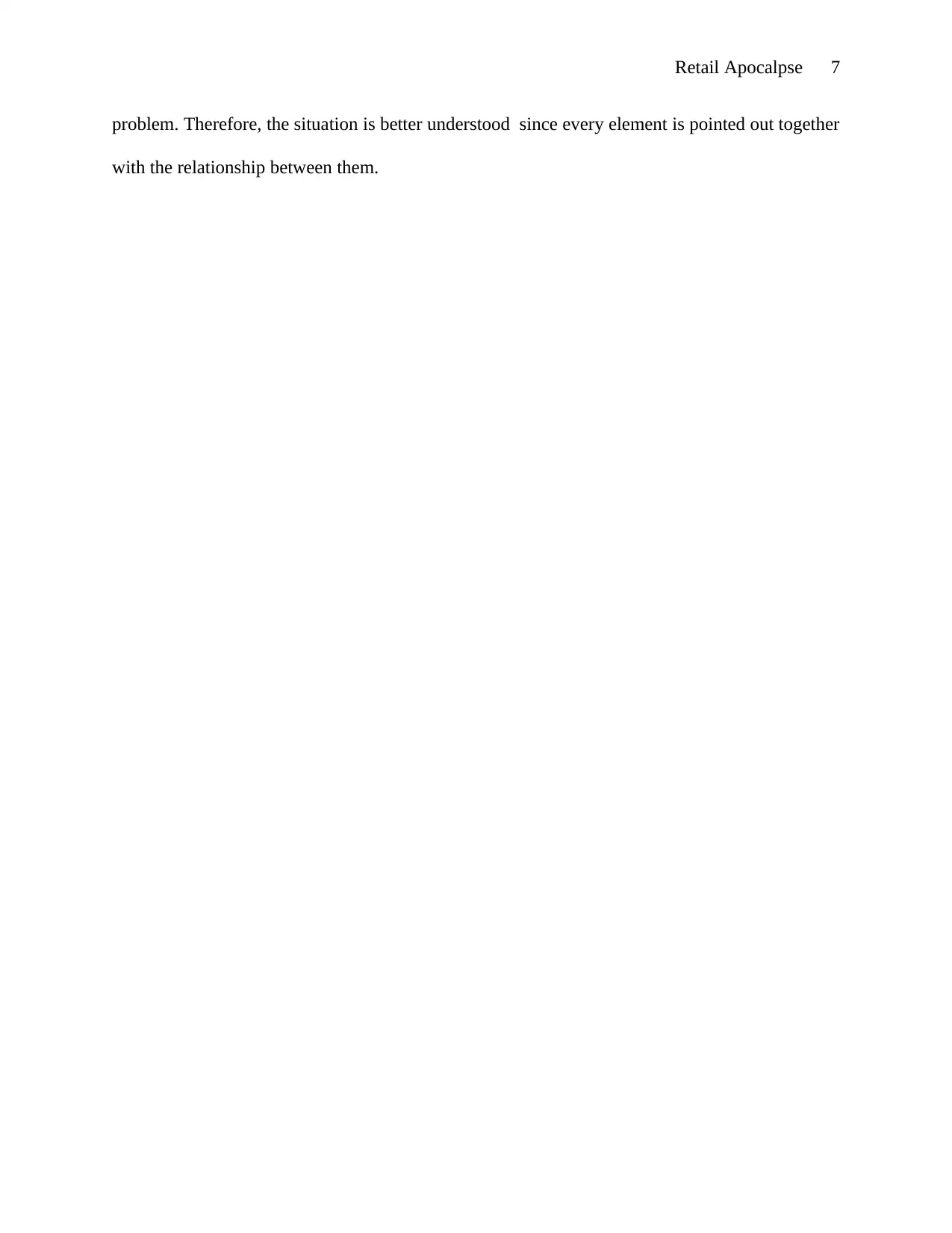
Retail Apocalpse 7
problem. Therefore, the situation is better understood since every element is pointed out together
with the relationship between them.
problem. Therefore, the situation is better understood since every element is pointed out together
with the relationship between them.
Paraphrase This Document
Need a fresh take? Get an instant paraphrase of this document with our AI Paraphraser
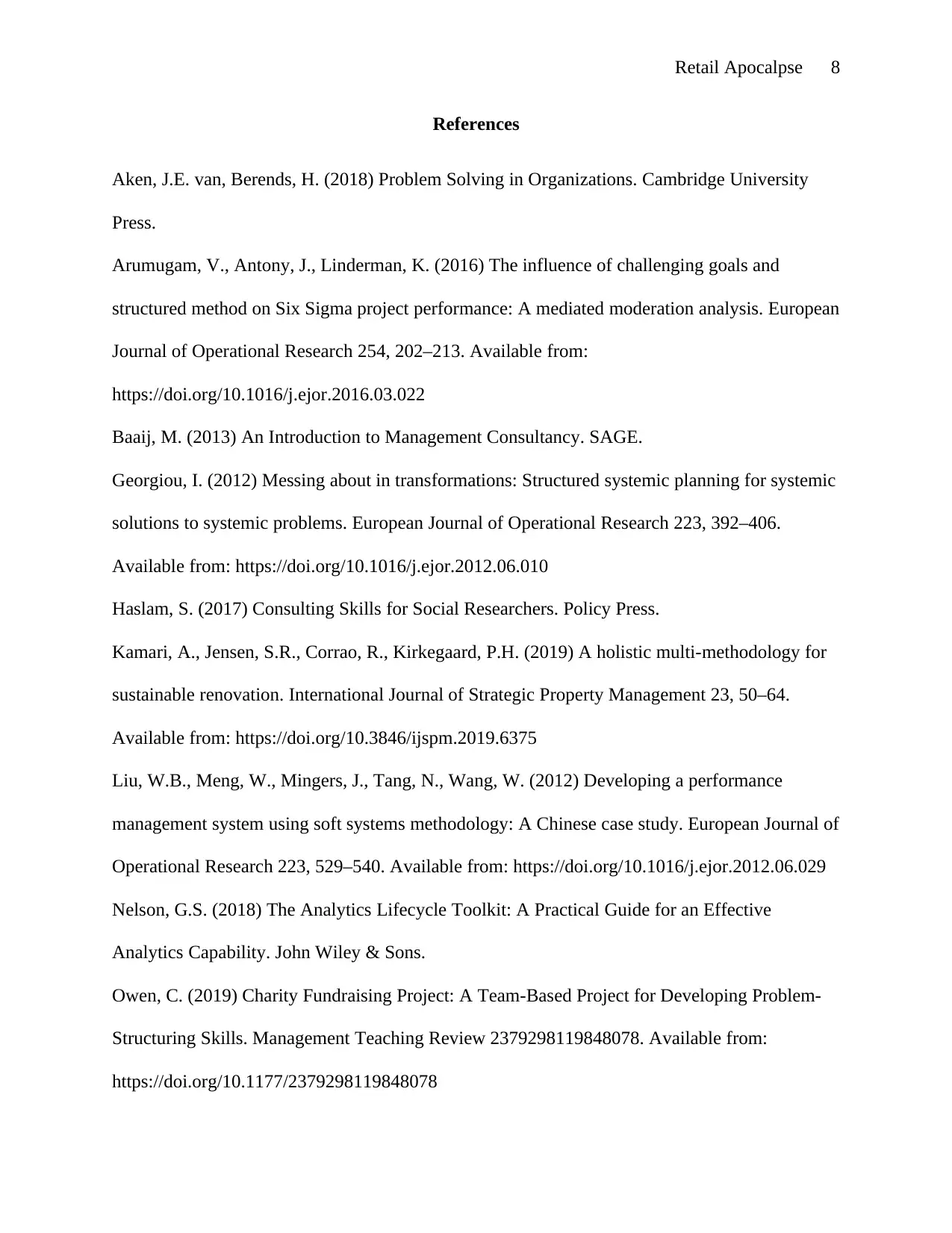
Retail Apocalpse 8
References
Aken, J.E. van, Berends, H. (2018) Problem Solving in Organizations. Cambridge University
Press.
Arumugam, V., Antony, J., Linderman, K. (2016) The influence of challenging goals and
structured method on Six Sigma project performance: A mediated moderation analysis. European
Journal of Operational Research 254, 202–213. Available from:
https://doi.org/10.1016/j.ejor.2016.03.022
Baaij, M. (2013) An Introduction to Management Consultancy. SAGE.
Georgiou, I. (2012) Messing about in transformations: Structured systemic planning for systemic
solutions to systemic problems. European Journal of Operational Research 223, 392–406.
Available from: https://doi.org/10.1016/j.ejor.2012.06.010
Haslam, S. (2017) Consulting Skills for Social Researchers. Policy Press.
Kamari, A., Jensen, S.R., Corrao, R., Kirkegaard, P.H. (2019) A holistic multi-methodology for
sustainable renovation. International Journal of Strategic Property Management 23, 50–64.
Available from: https://doi.org/10.3846/ijspm.2019.6375
Liu, W.B., Meng, W., Mingers, J., Tang, N., Wang, W. (2012) Developing a performance
management system using soft systems methodology: A Chinese case study. European Journal of
Operational Research 223, 529–540. Available from: https://doi.org/10.1016/j.ejor.2012.06.029
Nelson, G.S. (2018) The Analytics Lifecycle Toolkit: A Practical Guide for an Effective
Analytics Capability. John Wiley & Sons.
Owen, C. (2019) Charity Fundraising Project: A Team-Based Project for Developing Problem-
Structuring Skills. Management Teaching Review 2379298119848078. Available from:
https://doi.org/10.1177/2379298119848078
References
Aken, J.E. van, Berends, H. (2018) Problem Solving in Organizations. Cambridge University
Press.
Arumugam, V., Antony, J., Linderman, K. (2016) The influence of challenging goals and
structured method on Six Sigma project performance: A mediated moderation analysis. European
Journal of Operational Research 254, 202–213. Available from:
https://doi.org/10.1016/j.ejor.2016.03.022
Baaij, M. (2013) An Introduction to Management Consultancy. SAGE.
Georgiou, I. (2012) Messing about in transformations: Structured systemic planning for systemic
solutions to systemic problems. European Journal of Operational Research 223, 392–406.
Available from: https://doi.org/10.1016/j.ejor.2012.06.010
Haslam, S. (2017) Consulting Skills for Social Researchers. Policy Press.
Kamari, A., Jensen, S.R., Corrao, R., Kirkegaard, P.H. (2019) A holistic multi-methodology for
sustainable renovation. International Journal of Strategic Property Management 23, 50–64.
Available from: https://doi.org/10.3846/ijspm.2019.6375
Liu, W.B., Meng, W., Mingers, J., Tang, N., Wang, W. (2012) Developing a performance
management system using soft systems methodology: A Chinese case study. European Journal of
Operational Research 223, 529–540. Available from: https://doi.org/10.1016/j.ejor.2012.06.029
Nelson, G.S. (2018) The Analytics Lifecycle Toolkit: A Practical Guide for an Effective
Analytics Capability. John Wiley & Sons.
Owen, C. (2019) Charity Fundraising Project: A Team-Based Project for Developing Problem-
Structuring Skills. Management Teaching Review 2379298119848078. Available from:
https://doi.org/10.1177/2379298119848078
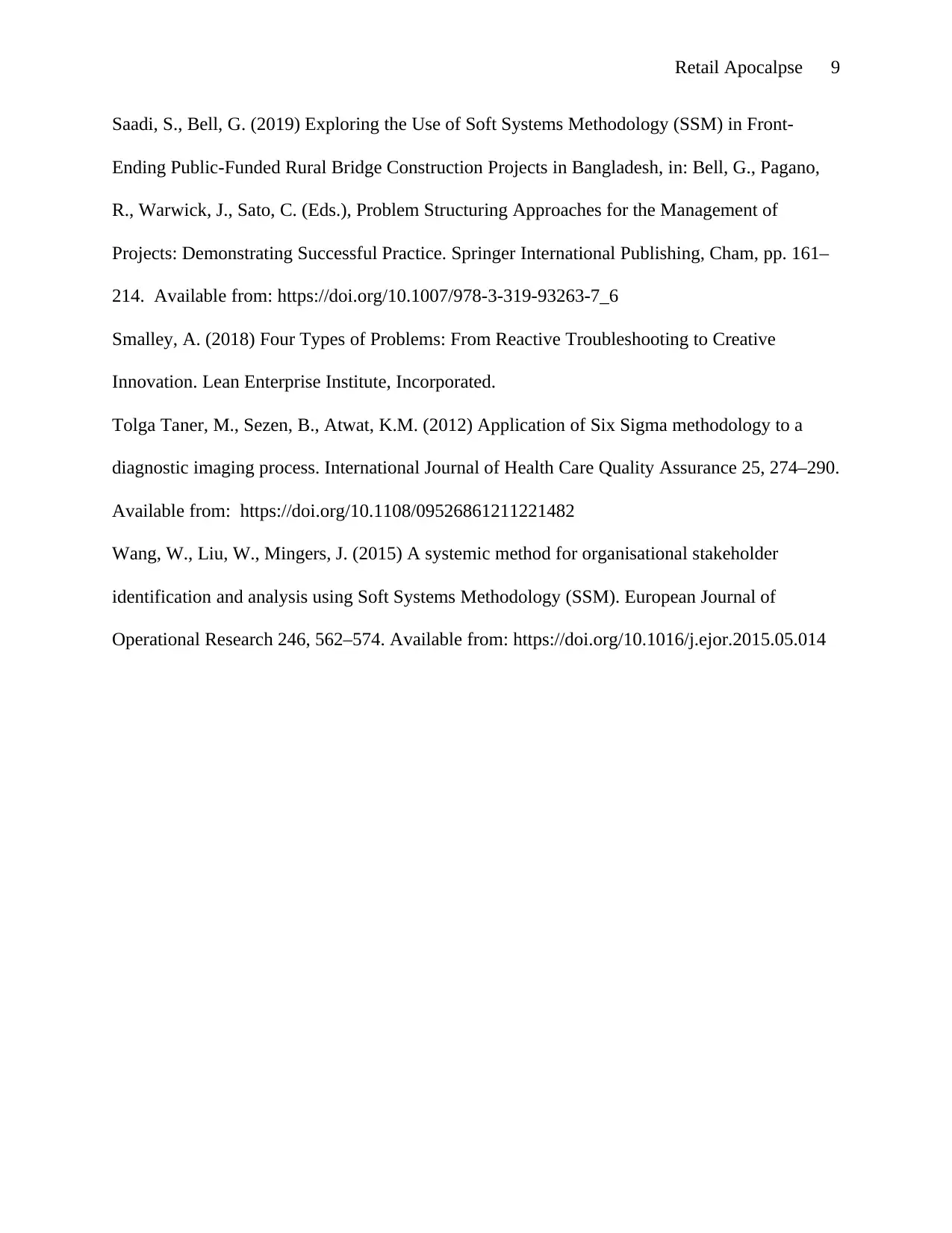
Retail Apocalpse 9
Saadi, S., Bell, G. (2019) Exploring the Use of Soft Systems Methodology (SSM) in Front-
Ending Public-Funded Rural Bridge Construction Projects in Bangladesh, in: Bell, G., Pagano,
R., Warwick, J., Sato, C. (Eds.), Problem Structuring Approaches for the Management of
Projects: Demonstrating Successful Practice. Springer International Publishing, Cham, pp. 161–
214. Available from: https://doi.org/10.1007/978-3-319-93263-7_6
Smalley, A. (2018) Four Types of Problems: From Reactive Troubleshooting to Creative
Innovation. Lean Enterprise Institute, Incorporated.
Tolga Taner, M., Sezen, B., Atwat, K.M. (2012) Application of Six Sigma methodology to a
diagnostic imaging process. International Journal of Health Care Quality Assurance 25, 274–290.
Available from: https://doi.org/10.1108/09526861211221482
Wang, W., Liu, W., Mingers, J. (2015) A systemic method for organisational stakeholder
identification and analysis using Soft Systems Methodology (SSM). European Journal of
Operational Research 246, 562–574. Available from: https://doi.org/10.1016/j.ejor.2015.05.014
Saadi, S., Bell, G. (2019) Exploring the Use of Soft Systems Methodology (SSM) in Front-
Ending Public-Funded Rural Bridge Construction Projects in Bangladesh, in: Bell, G., Pagano,
R., Warwick, J., Sato, C. (Eds.), Problem Structuring Approaches for the Management of
Projects: Demonstrating Successful Practice. Springer International Publishing, Cham, pp. 161–
214. Available from: https://doi.org/10.1007/978-3-319-93263-7_6
Smalley, A. (2018) Four Types of Problems: From Reactive Troubleshooting to Creative
Innovation. Lean Enterprise Institute, Incorporated.
Tolga Taner, M., Sezen, B., Atwat, K.M. (2012) Application of Six Sigma methodology to a
diagnostic imaging process. International Journal of Health Care Quality Assurance 25, 274–290.
Available from: https://doi.org/10.1108/09526861211221482
Wang, W., Liu, W., Mingers, J. (2015) A systemic method for organisational stakeholder
identification and analysis using Soft Systems Methodology (SSM). European Journal of
Operational Research 246, 562–574. Available from: https://doi.org/10.1016/j.ejor.2015.05.014
⊘ This is a preview!⊘
Do you want full access?
Subscribe today to unlock all pages.

Trusted by 1+ million students worldwide
1 out of 9
Your All-in-One AI-Powered Toolkit for Academic Success.
+13062052269
info@desklib.com
Available 24*7 on WhatsApp / Email
![[object Object]](/_next/static/media/star-bottom.7253800d.svg)
Unlock your academic potential
Copyright © 2020–2025 A2Z Services. All Rights Reserved. Developed and managed by ZUCOL.